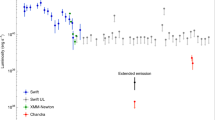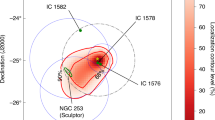Abstract
Ultraluminous X-ray sources (ULXs) are bright X-ray sources in nearby galaxies not associated with the central supermassive black hole. Their luminosities imply they are powered by either an extreme accretion rate onto a compact stellar remnant, or an intermediate mass (~100–105 M⊙) black hole1. Recently detected coherent pulsations coming from three bright ULXs2,3,4,5 demonstrate that some of these sources are powered by accretion onto a neutron star, implying accretion rates significantly in excess of the Eddington limit, a high degree of geometric beaming, or both. The physical challenges associated with the high implied accretion rates can be mitigated if the neutron star surface field is very high (1014 G)6, since this suppresses the electron scattering cross-section, reducing the radiation pressure that chokes off accretion for high luminosities. Surface magnetic field strengths can be determined through cyclotron resonance scattering features7,8 produced by the transition of charged particles between quantized Landau levels. Here, we present the detection at a significance of 3.8σ of an absorption line at 4.5 keV in the Chandra spectrum of a ULX in M51. This feature is likely to be a cyclotron resonance scattering feature produced by the strong magnetic field of a neutron star. Assuming scattering off electrons, the magnetic field strength is implied to be ~1011 G, while protons would imply a magnetic field of B ~ 1015 G.
This is a preview of subscription content, access via your institution
Access options
Access Nature and 54 other Nature Portfolio journals
Get Nature+, our best-value online-access subscription
$29.99 / 30 days
cancel any time
Subscribe to this journal
Receive 12 digital issues and online access to articles
$119.00 per year
only $9.92 per issue
Buy this article
- Purchase on Springer Link
- Instant access to full article PDF
Prices may be subject to local taxes which are calculated during checkout

Similar content being viewed by others
References
Farrell, S. A., Webb, N. A., Barret, D., Godet, O. & Rodrigues, J. M. An intermediate-mass black hole of over 500 solar masses in the galaxy ESO243-49. Nature 460, 73–75 (2009).
Bachetti, M. et al. An ultraluminous X-ray source powered by an accreting neutron star. Nature 514, 202–204 (2014).
Fürst, F. et al. Discovery of coherent pulsations from the ultraluminous X-ray source NGC 7793 P13. Astrophys. J. 831, L14 (2016).
Israel, G. L. et al. Discovery of a 0.42-s pulsar in the ultraluminous X-ray source NGC 7793 P13. Mon. Not. R. Astron. Soc. 466, L48–L52 (2017).
Israel, G. L. et al. An accreting pulsar with extreme properties drives an ultraluminous X-ray source in NGC 5907. Science 355, 817–819 (2017).
Dall’Osso, S., Perna, R. & Stella, L. NuSTAR J095551+6940.8: a highly magnetized neutron star with super-Eddington mass accretion. Mon. Not. R. Astron. Soc. 449, 2144–2150 (2015).
Gnedin, I. N. & Sunyaev, R. A. Polarization of optical and X-radiation from compact thermal sources with magnetic field. Astron. Astrophys. 36, 379–394 (1974).
Truemper, J. et al. Evidence for strong cyclotron line emission in the hard X-ray spectrum of Hercules X-1. Astrophys. J. 219, L105–L110 (1978).
Palumbo, G. G. C., Fabbiano, G., Trinchieri, G. & Fransson, C. An X-ray study of M51 (NGC 5194) and its companion (NGC 5195). Astrophys. J. 298, 259–267 (1985).
McQuinn, K. B. W., Skillman, E. D., Dolphin, A. E., Berg, D. & Kennicutt, R. The distance to M51. Astrophys. J. 826, 21 (2016).
Liu, Q. Z. & Mirabel, I. F. A catalogue of ultraluminous X-ray sources in external galaxies. Astron. Astrophys. 429, 1125–1129 (2005).
Dewangan, G. C., Griffiths, R. E., Choudhury, M., Miyaji, T. & Schurch, N. J. XMM-Newton view of the ultraluminous X-ray sources in M51. Astrophys. J. 635, 198–213 (2005).
Gladstone, J. C., Roberts, T. P. & Done, C. The ultraluminous state. Mon. Not. R. Astron. Soc. 397, 1836–1851 (2009).
Pinto, C., Middleton, M. J. & Fabian, A. C. Resolved atomic lines reveal outflows in two ultraluminous X-ray sources. Nature 533, 64–67 (2016).
Walton, D. J. et al. An iron K component to the ultrafast outflow in NGC 1313 X-1. Astrophys. J. 826, L26 (2016).
Lusso, E. et al. The bolometric output and host-galaxy properties of obscured AGN in the XMM-COSMOS survey. Astron. Astrophys. 534, A110 (2011).
Heida, M. et al. Near-infrared counterparts of ultraluminous X-ray sources. Mon. Not. R. Astron. Soc. 442, 1054–1067 (2014).
Jaisawal, G. K. & Naik, S. Detection of cyclotron resonance scattering feature in high-mass X-ray binary pulsar SMC X-2. Mon. Not. R. Astron. Soc. 461, L97–L101 (2016).
Tsygankov, S. S., Lutovinov, A. A., Churazov, E. M. & Sunyaev, R. A. V0332+53 in the outburst of 2004-2005: luminosity dependence of the cyclotron line and pulse profile. Mon. Not. R. Astron. Soc. 371, 19–28 (2006).
Ibrahim, A. I. et al. Discovery of cyclotron resonance features in the soft gamma repeater SGR 1806-20. Astrophys. J. 574, L51–L55 (2002).
Tiengo, A. et al. A variable absorption feature in the X-ray spectrum of a magnetar. Nature 500, 312–314 (2013).
Kouveliotou, C. et al. An X-ray pulsar with a superstrong magnetic field in the soft γ-ray repeater SGR1806 – 20. Nature 393, 235–237 (1998).
Bezchastnov, V. G., Pavlov, G. G., Shibanov, Y. A. & Zavlin, V. E. Radiative opacities and photosphere models for soft gamma repeaters. AIP Conf. Proc 384, 907–912 (1996).
Zane, S., Turolla, R., Stella, L. & Treves, A. Proton cyclotron features in thermal spectra of ultramagnetized neutron stars. Astrophys. J. 560, 384–389 (2001).
Ho, W. C. G. & Lai, D. Atmospheres and spectra of strongly magnetized neutron stars. Mon. Not. R. Astron. Soc. 327, 1081–1096 (2001).
Potekhin, A. Y. & Lai, D. Statistical equilibrium and ion cyclotron absorption/emission in strongly magnetized plasmas. Mon. Not. R. Astron. Soc. 376, 793–808 (2007).
Araya, R. A. & Harding, A. K. Cyclotron line features from near-critical magnetic fields: the effect of optical depth and plasma geometry. Astrophys. J. 517, 334–354 (1999).
Kuntz, K. D., Long, K. S. & Kilgard, R. E. A deep Chandra ACIS survey of M51. Astrophys. J. 827, 46 (2016).
Acknowledgements
M.J.M. and D.J.W. appreciate support from Ernest Rutherford Science and Technology Facilities Council fellowships. The work of D.S. was carried out at the Jet Propulsion Laboratory, California Institute of Technology, under a contract with the National Aeronautics and Space Administration.
Author information
Authors and Affiliations
Contributions
M. Brightman reduced and analysed the Chandra and XMM-Newton data. F.F. performed timing analysis of the Chandra and XMM-Newton data. M.H. analysed the ULX multiwavelength counterpart. M. Brightman, F.A.H., F.F., M.J.M., D.J.W., A.C.F., D.B. and M. Bachetti interpreted the results. M. Brightman, F.A.H., D.J.W. and D.S. prepared the manuscript.
Corresponding author
Ethics declarations
Competing interests
The authors declare no competing interests.
Additional information
Publisher’s note: Springer Nature remains neutral with regard to jurisdictional claims in published maps and institutional affiliations.
Rights and permissions
About this article
Cite this article
Brightman, M., Harrison, F.A., Fürst, F. et al. Magnetic field strength of a neutron-star-powered ultraluminous X-ray source. Nat Astron 2, 312–316 (2018). https://doi.org/10.1038/s41550-018-0391-6
Received:
Accepted:
Published:
Issue Date:
DOI: https://doi.org/10.1038/s41550-018-0391-6
This article is cited by
-
X-ray astronomy comes of age
Nature (2022)
-
Ultra-bright and maybe ludicrously magnetic
Nature Astronomy (2018)



